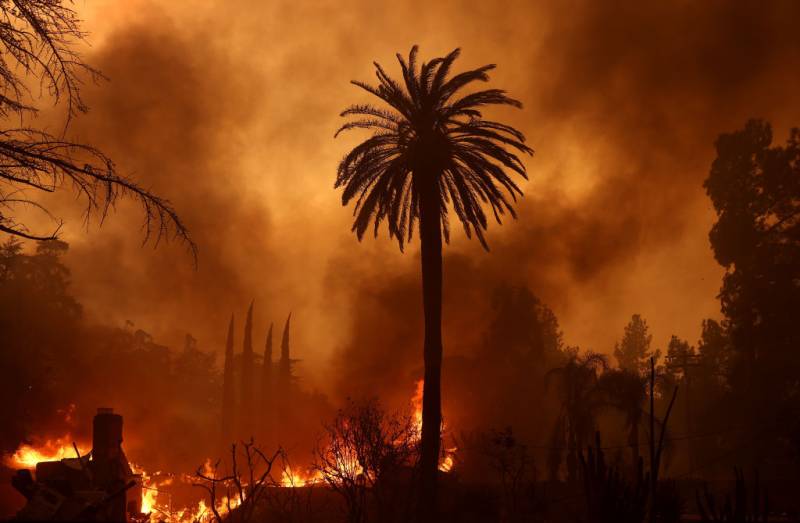Climate Whiplash: A Growing Threat To Urban Areas Worldwide

Table of Contents
Increased Frequency and Intensity of Extreme Weather Events
Climate whiplash manifests in the increased frequency and intensity of extreme weather events, placing unprecedented strain on urban infrastructure and populations.
Heatwaves and their Urban Impact
Cities are particularly vulnerable to heatwaves due to the urban heat island effect, where built-up areas trap heat, leading to significantly higher temperatures than surrounding rural areas. This intensifies the health risks associated with heatwaves, including heatstroke, cardiovascular issues, and increased mortality rates, particularly among vulnerable populations such as the elderly and those with pre-existing health conditions.
- Increased energy demand: Heatwaves drive up electricity consumption for air conditioning, straining power grids and potentially leading to outages.
- Strain on healthcare systems: Hospitals and emergency services face increased pressure during heatwaves, dealing with a surge in heat-related illnesses.
- Damage to infrastructure: Extreme heat can damage roads, railways, and other infrastructure through expansion and contraction of materials.
- Social equity issues: Vulnerable populations, often lacking access to air conditioning or adequate housing, are disproportionately affected by extreme heat.
Flooding and its Devastating Consequences
Rising sea levels and intense rainfall are contributing to a significant increase in the frequency and severity of urban flooding. This leads to substantial economic losses, displacement of populations, and damage to critical infrastructure.
- Damage to transportation networks: Floods disrupt road, rail, and public transport systems, severely impacting commutes and the delivery of essential goods and services.
- Water contamination: Floodwaters often contaminate drinking water sources, increasing the risk of waterborne diseases.
- Loss of property: Flooding causes extensive damage to homes and businesses, resulting in significant financial losses and displacement.
- Disruption of essential services: Floods can disrupt power supplies, communication networks, and other essential services, hindering recovery efforts.
Droughts and Water Scarcity
Climate whiplash also manifests as prolonged droughts, impacting water supplies and agriculture in urban regions. This creates challenges for water management and has implications for food security and public health.
- Restrictions on water usage: Droughts necessitate water restrictions, impacting industries, agriculture, and daily life.
- Increased water prices: Water scarcity drives up prices, making water unaffordable for many.
- Agricultural losses: Droughts reduce crop yields, impacting food security and potentially leading to food price increases.
- Conflicts over water resources: Competition for dwindling water resources can lead to conflicts between different stakeholders.
The Challenges to Urban Resilience and Adaptation
Building urban resilience to climate whiplash requires addressing critical infrastructure vulnerabilities, economic impacts, and social equity issues, and implementing proactive mitigation strategies.
Infrastructure Vulnerabilities
Existing urban infrastructure is often ill-equipped to handle the increased frequency and intensity of extreme weather events.
- Aging water systems: Outdated water systems are vulnerable to leaks, breaks, and contamination during floods.
- Inadequate drainage systems: Insufficient drainage capacity leads to rapid flooding during intense rainfall.
- Vulnerability of transportation networks: Roads, bridges, and tunnels can be damaged or destroyed by floods, high winds, or extreme temperatures.
- Insufficient early warning systems: Lack of robust early warning systems hampers timely evacuation and response efforts.
Economic Impacts and Social Equity
Climate whiplash has significant economic consequences, disproportionately affecting vulnerable populations.
- Increased insurance costs: The increased risk of extreme weather events drives up insurance premiums, making it unaffordable for some.
- Loss of jobs: Extreme weather events can disrupt businesses, leading to job losses and economic hardship.
- Displacement of residents: Flooding and other extreme weather events force people to leave their homes, leading to displacement and homelessness.
- Widening socio-economic inequalities: Vulnerable populations are often hit hardest by the economic impacts of climate whiplash, exacerbating existing inequalities.
Planning and Mitigation Strategies
Building more resilient urban environments requires a multi-pronged approach.
- Investing in green infrastructure: Green roofs, urban forests, and permeable pavements can help mitigate the urban heat island effect and reduce flooding.
- Promoting sustainable urban planning: Designing cities that are more resilient to extreme weather events requires careful planning and zoning regulations.
- Implementing early warning systems: Robust early warning systems can provide timely alerts, allowing for effective evacuation and response.
- Community-based disaster preparedness: Community engagement and preparedness initiatives are crucial for effective disaster response and recovery.
Global Case Studies of Climate Whiplash Impacts
Several cities illustrate the devastating impact of climate whiplash. Houston, Texas, experienced catastrophic flooding during Hurricane Harvey in 2017, highlighting the vulnerability of coastal cities to extreme rainfall. Mumbai, India, regularly faces severe monsoon flooding, overwhelming its drainage infrastructure and displacing thousands. London, experiencing record-breaking heatwaves, shows the vulnerability of even temperate cities to climate change impacts.
Conclusion
The increasing threat of climate whiplash to urban areas is undeniable. Its devastating consequences, ranging from infrastructure damage to economic losses and social inequities, demand urgent action. Building more resilient urban environments requires a multifaceted approach, incorporating improved infrastructure, sustainable urban planning, early warning systems, and community engagement. Understanding and addressing the challenges of managing climate whiplash is crucial for the future of our cities. Learn more about how you can contribute to building more resilient urban environments and mitigating the impacts of climate whiplash. Let's work together to reduce climate whiplash risks and create sustainable, thriving urban communities.

Featured Posts
-
 Adanali Ronaldodan Cristiano Ronaldo Ya Cevap Gercekler Ve Detaylar
May 28, 2025
Adanali Ronaldodan Cristiano Ronaldo Ya Cevap Gercekler Ve Detaylar
May 28, 2025 -
 La Seleccion Espanola De Atletismo Para El Mundial Indoor De Nanjing
May 28, 2025
La Seleccion Espanola De Atletismo Para El Mundial Indoor De Nanjing
May 28, 2025 -
 Stowers Home Run Heroics Lead Marlins To Victory Over Cubs
May 28, 2025
Stowers Home Run Heroics Lead Marlins To Victory Over Cubs
May 28, 2025 -
 Liverpools Transfer Plans Focus On Wingers While Negotiating Mo Salahs Contract
May 28, 2025
Liverpools Transfer Plans Focus On Wingers While Negotiating Mo Salahs Contract
May 28, 2025 -
 Padres Losing Streak Faces A Tough Test In Atlanta
May 28, 2025
Padres Losing Streak Faces A Tough Test In Atlanta
May 28, 2025
